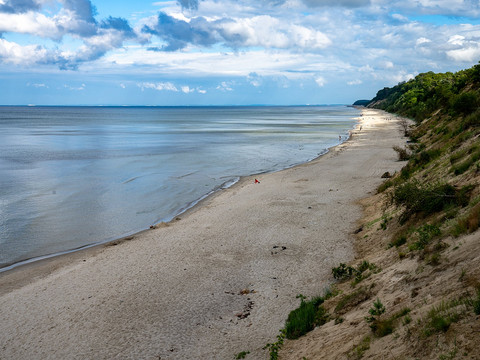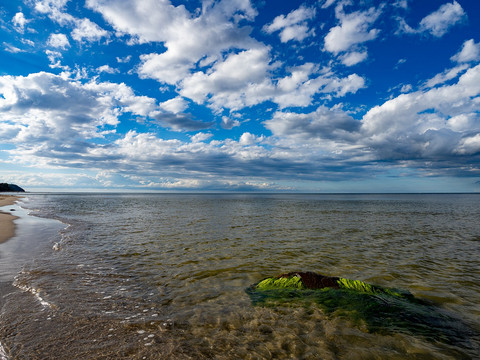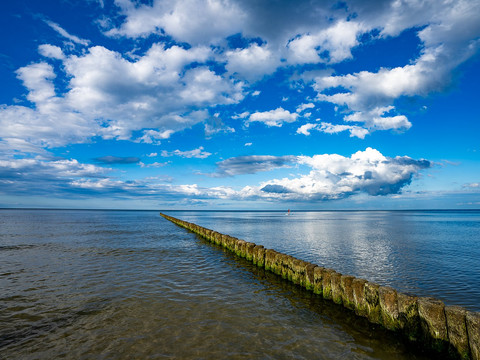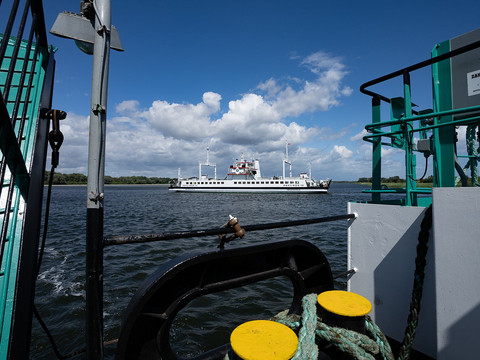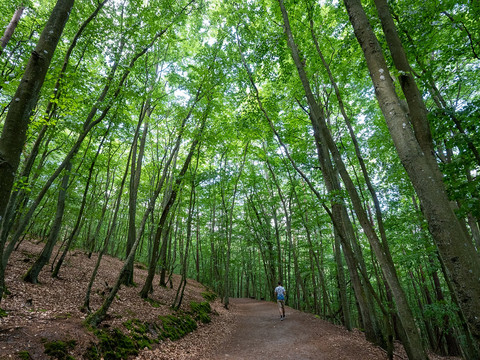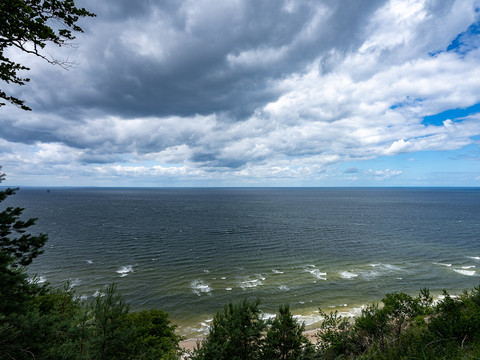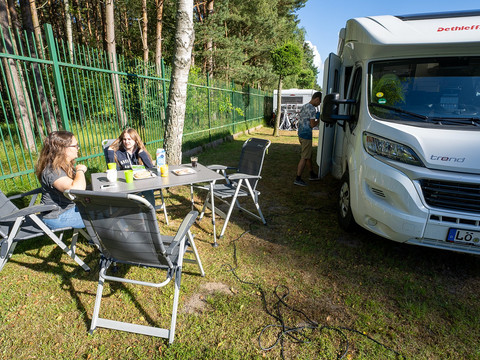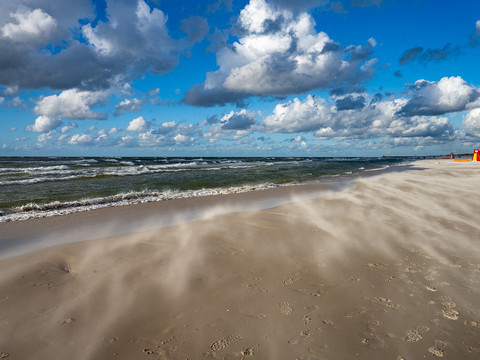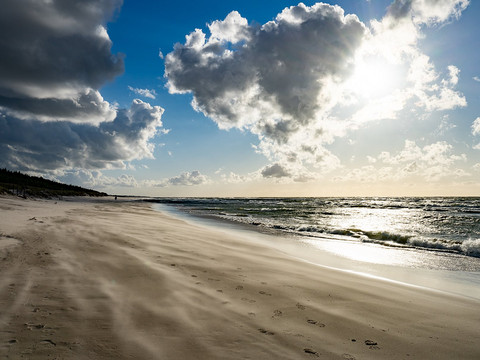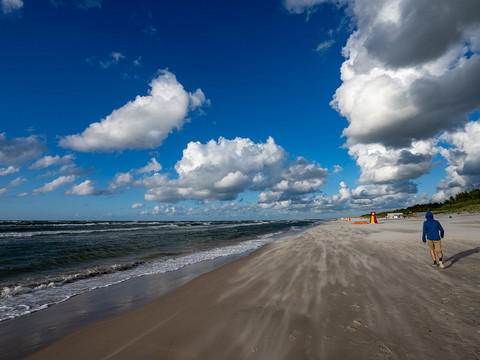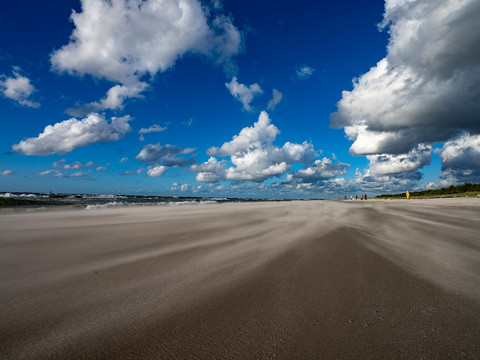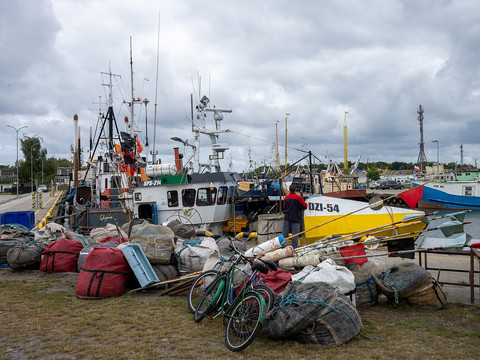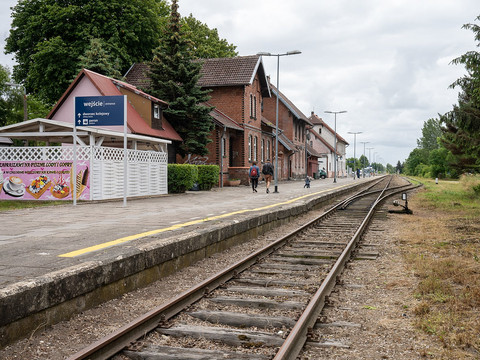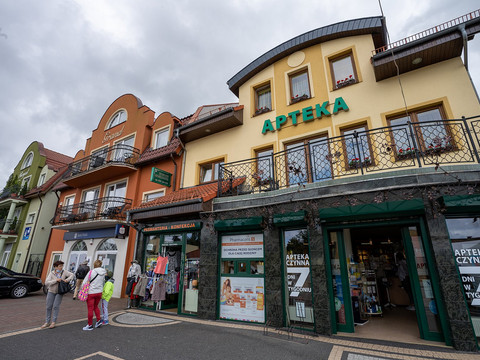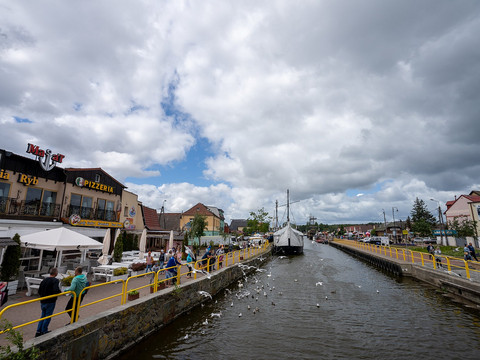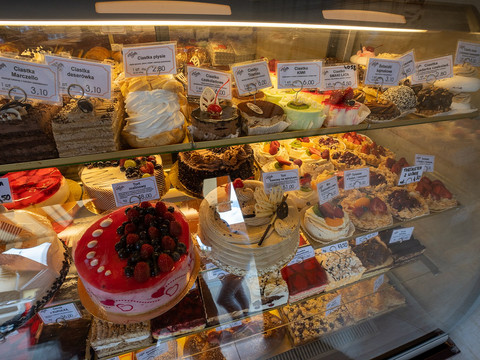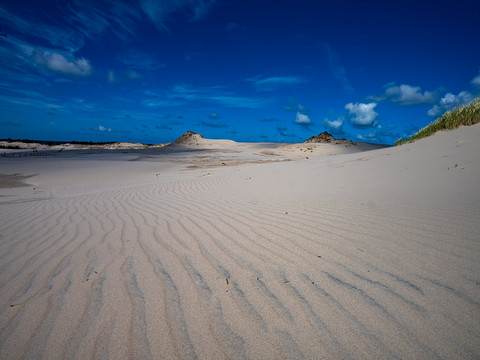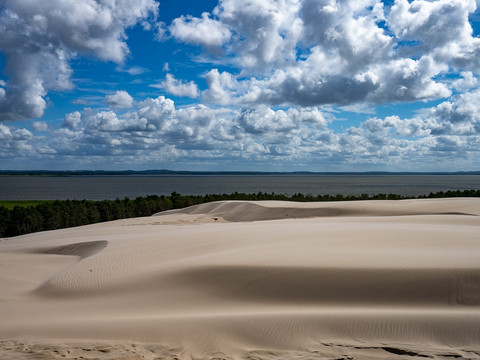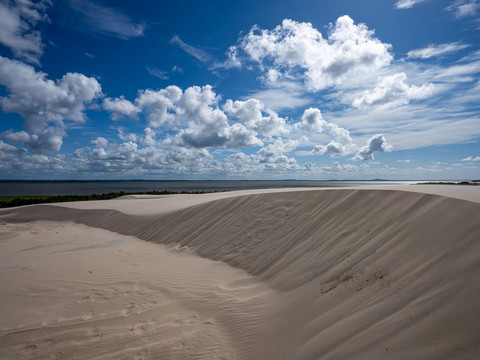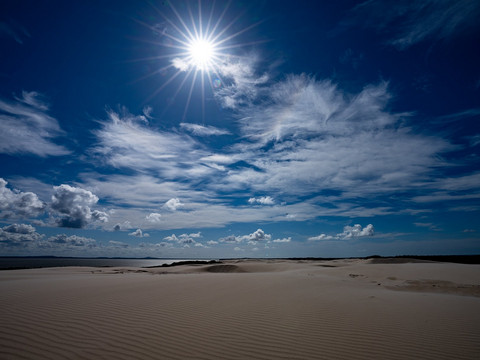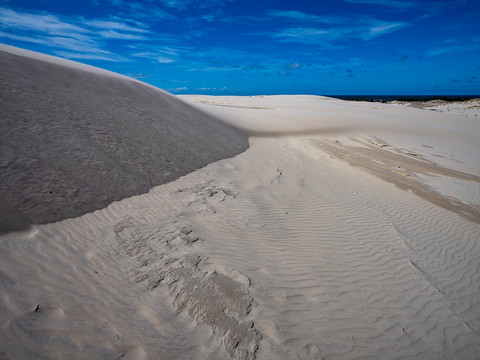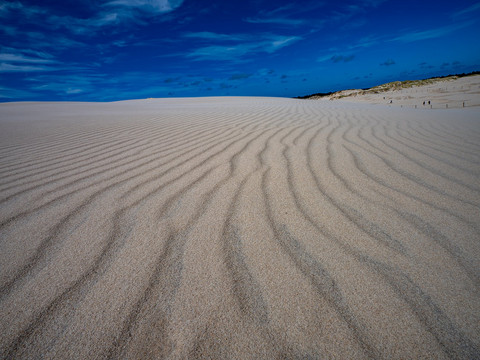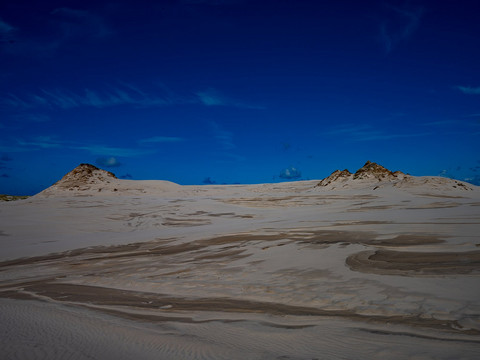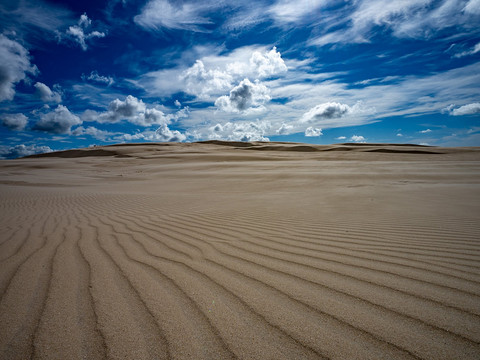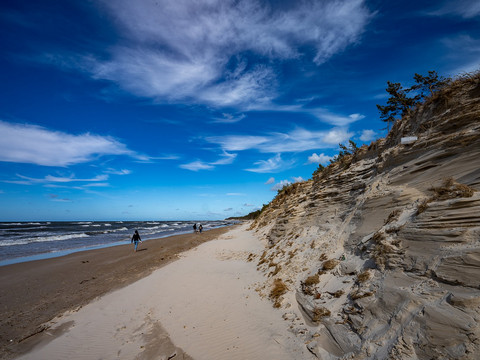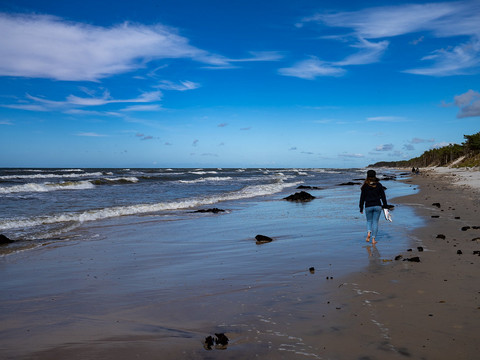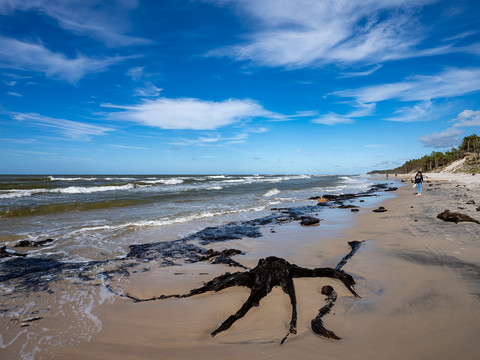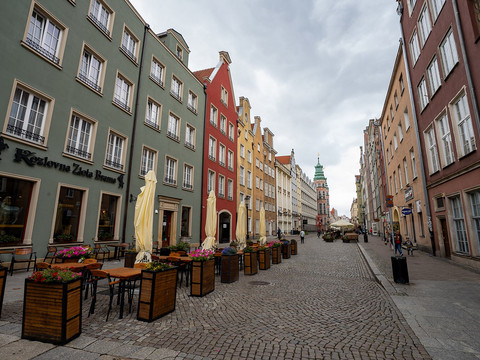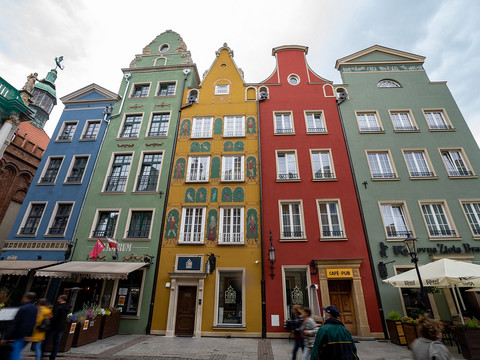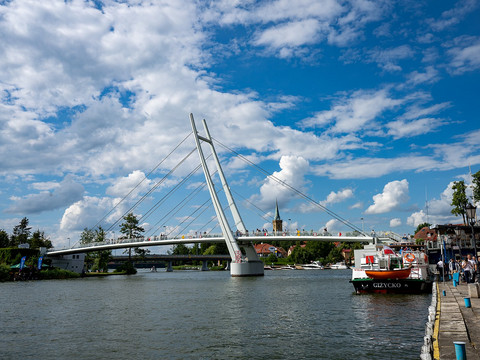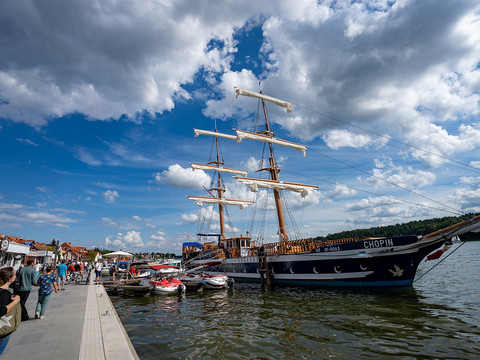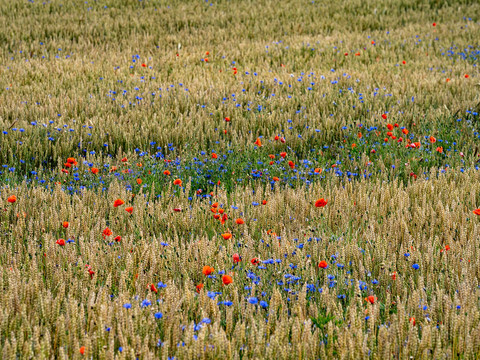There are many reasons for a vacation on the Polish Baltic coast: Not only is it at least as beautiful as the German side - the prices for food and hotels are much lower. More than 800 kilometers of gorgeous sandy beaches - sometimes busy, sometimes secluded - line Poland's Baltic coast. Historic fishing villages and time-honored seaside resorts invite visitors to feast, swim, relax and enjoy water sports. And on top of that, the white dunes of the Slowinski National Park beckon.
The Polish Baltic Sea coast stretches over 800 kilometers from the border on Usedom to the Vistula Lagoon on the Russian exclave of Kaliningrad. In the western part are many seaside resorts that were popular destinations even in imperial times. The further east you go, the more pristine the landscape becomes. Often only a few kilometers south of the sea are lake districts, which are particularly scenic. The Baltic coast and its climate, a mixture of maritime and continental, is definitely suitable as a year-round destination. Summers are a little warmer than on the North Sea, but it's a bit colder in winter. For a beach vacation with family I recommend the months of July and August, when the Baltic Sea usually cracks the 20 degree mark. Spring and fall are ideal if you want to go hiking or sightseeing. If your focus is on wellness and relaxation, even winter can be the perfect time to travel. After a walk on the beach in the icy cold, there is nothing better than warming up in the sauna.
With the Szczecin Lagoon and the two islands of Usedom and Wollin, the Polish Baltic Sea coast shows its most beautiful side right at the start: with wide beaches and high cliffs. The gateway to the Baltic Sea is Szczecin, 60 km from the coast, with a medieval old town and colorfully decorated gabled houses, maritime flair and a vibrant cultural life.
Directly on the Baltic Sea and only an hour's walk along the beach from Ahlbeck on the German part of Usedom is the island's oldest seaside resort: Świnoujście (Swinemünde). Due to the visits of Wilhelm II, the place became famous as "Kaiserbad". Together with the three imperial resorts of Bansin, Heringsdorf and Ahlbeck, the town is located on the longest beach promenade in Europe. The city center and the spa district of Swinemünde with its historic villas in the style of seaside resort architecture are on Usedom, but the ferry port is already on the Wollin peninsula. Free ferries connect the districts. Many villas from the heyday of the imperial spas have been preserved, and not only in the old town. The town's landmark is the lighthouse with a stately height of 68 meters, the highest on the Baltic Sea. Impressive are the forts in the surrounding area: from the round Engelsburg you walk to the well-camouflaged Westburg, where you can eat well: Huge portions of meat are dished up in the brick vault of the Powder Chamber.
The seaside resort of Międzyzdroje (Misdroy), already popular in German times, today offers everything that makes the lively resorts of the Polish coast attractive for families: fine sandy beaches as well as a two-kilometer-long beach promenade with a pier, colorful stalls, various snack stands and restaurants with freshly caught delicacies. The Wollin National Park to the east of the seaside resort offers pure natural idyll with the bison park in the fragrant beech forest, which is crossed by long, beautiful hiking trails. The park with grazing bisons, wild boars and red deer is a worthwhile destination not only for children. A natural history museum provides information about the rich flora and fauna and shows exhibitions of nature photography and painting. The two towns of Wollin and Kamien Pomorski are located on the side of the island facing the mainland on the Szczecin Lagoon. The pretty town of Wollin is one of the oldest in the region. Worth seeing is the open-air museum, which gives you an insight into the life of the Slavs and Vikings. In the village of Sulomino, the Western Picnic with folk, blues, country and bluegrass music takes place in the summer. Kamien Pomorski is situated on the Cammin Bodden. The town is surrounded by dense forests and has become a well-known health resort due to its healing waters and moors.
One of the largest and most famous seaside resorts on the Baltic coast in Poland is Kołobrzeg (Kolberg), the county seat of the region. In 2007, the town at the mouth of the Parseta River celebrated its 750th anniversary. The beach promenade is lined with colorful stalls hawking amber and other souvenirs. Today, you can't tell that the town was almost completely destroyed during World War II: The buildings have been faithfully rebuilt. Incidentally, thanks to its natural brine springs, sea air and healing moors, Kolberg has been a popular health resort since the 19th century.
Nature romantics love the seaside resort of Łeba on the 500-hectare impressive Słowiński National Park, a Unesco biosphere reserve. Famous for its snow-white shifting sand dunes, up to 50 meters high, which are shifted by the wind at a speed of up to ten meters per year. A bike path or a one-hour walk along the coast will take you to the "Polish Sahara", the Slovenian National Park with its white shifting sand dunes. Unique are also the shallow coastal lakes, former seawater bays cut off from the Baltic Sea. By the way, the beach at the seaside resort of Łeba is fine sand and ideal for children.
A little further east, the Hel Peninsula off the Bay of Gdansk, which is around 35 kilometers long and only 200 meters narrow in places, beckons as a paradise for water and trend sports enthusiasts. Thanks to its special wind conditions, the peninsula is considered one of the best kitesurfing spots in Europe. Shipwrecks off the island are also popular destinations for divers. Beautiful sandy beaches with dunes line the long, thin headland. The town of Hel on the southern tip is a pretty little seaside resort with half-timbered houses. There is also an active fishing port here. Worth a visit is the Fokarium, a seal sanctuary that also cares for the preservation of these animals. In neighboring Jurata, you can walk across a pier that is partially built over the water. This is the site of the annual Kite-Surf Trophy, where the best kiters in Europe gather.
On the mainland coast opposite the Hel Peninsula you will find other idyllic places. Puck's (Putzig) Freedom Square with its historic town hall, magnificent town houses and the Gothic brick church of Peter-and-Paul is the destination of an annual pilgrimage that starts in Hel on June 29. Puck also offers a beautiful beach where many kite surfers can be seen. If you want to see it from the air, go parasailing.
If the fine sandy beaches in Hel are too crowded for you, you can go to the beaches of Gdansk or Gdynia, with which Sopot forms the so-called "Trójmiasto" ("Tri-City"): You can easily reach these places by bike along the well-kept bike paths along the promenade and the coast. Or you can come in September: the water in Gdansk Bay keeps the summer warmth long enough to go swimming even then.
In the southwestern corner of the Bay of Gdansk there are three different bordering cities that have been working very closely together since 2007. The northernmost city, Gdynia, attracts visitors with three museum ships and a large aquarium. South of it lies one of the most popular spa and bathing resorts on the Polish Baltic coast, Sopot. The center is characterized by magnificent buildings from the late 19th and early 20th centuries. The pedestrian zone turns into a party mile in summer, ending at the beach with the longest pier in Europe. With the Sopot Forest Opera, the city offers a cultural attraction. In the south lies the Hanseatic city of Gdansk, which can look back on a long and eventful history. The old town, which was faithfully rebuilt after the war, was the filming location for the famous television series "The Buddenbrooks" based on a novel by Thomas Mann.
East of Gdansk and the mouth of the Vistula lies the town of Stegna, with a stretch of coastline known for the frequent discovery of amber on the beach, especially after storms. Jantar is even considered the secret capital of amber, which is duly honored with the annual world championship in amber collecting.
Even further east, the "Vistula Spit" separates the "Vistula Lagoon" from the Baltic Sea. The spit is about 70 kilometers long and maximum 2 kilometers wide. About in the middle runs the border to the Russian exclave Kaliningrad. The landscape is characterized by sandy dunes and pine forests. At the western end lies Katie Rybackie, formerly Bodenwinkel. The small town borders on the Mierzeja Wislana Nature Park, where many rare bird species can be observed and boat tours of the spit also start.
Further south, it is worth taking a detour to the Masurian Lake District - the land of 1000 lakes. There are many regions with lakes and forests, but one exerts a special magic: Masuria, that world-forgotten area in northwestern Poland, where it seems that time stood still years ago. The heart of Masuria is the Great Lake District with the vacation centers of Gizycko in the north and Mikolajki in the south. Here the lakes are strung together like pearls and connected by canals - an Eldorado for water sports enthusiasts of all kinds. Countless sailboats cavort on the lakes. Many vacationers also explore the lake landscape by houseboat or kayak. Those who wish can also explore the region from the water by excursion boat.

To properly prepare for your trip
How to get there:
By own car or by train
How long to go:
1 - 2 weeks
Best time to travel:
All year round
Highlights:
Woolin National Park, White Dunes in the Slovakian National Park, Masurian Lake District, Gdansk.
Excursion tips:
www.getyourguide.ch
More info:
www.polen.travel/de
Realised by Michael Bachmann
Further travel pictures under www.kissed-by-nature.com

